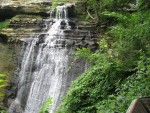Ohio, The Buckeye State

by Sandra Merville Hart
Ohio’s nickname is the Buckeye State, which is the state tree.
The Ohio River is the state’s southern border—and most of its eastern border. The river was named for an Iroquois or Seneca word—sources disagree on the Native American tribe—for “beautiful river.” The state takes its name from the river, which was named first.
The early history of Ohio
Though the French were the first to arrive in the Ohio area in 1669, both the French and British claimed it. The Iroquois, Chippewa, Shawnee, Delaware, Wyandot, Ojibwa, Miami, Kaskaskia, Seneca, Ottawa, and Sauk are a few of the Native Americans who lived in the area.
In 1763, France lost the French and Indian War and the British won control of the land. After the Revolutionary War, former soldiers settled in the Northwest Territory. They built Marietta, the first permanent white settlement, in 1788.
Native Americans fought the expansion. They lost the Battle of Fallen Timbers in 1794 and gave up much of the land of Ohio.
Ohio River
Many pioneers traveled to the Northwest Territory, as a large area including Ohio was known, on the Ohio River. The river flows along the borders of Pennsylvania, West Virginia, Ohio, Kentucky, Indiana, and Illinois so they could travel a long way by boat.
Ohio becomes a state
Ohio became the 17th state on March 1, 1803.
Johnny Appleseed
Born in Massachusetts in 1774, John Chapman started being called “Johnny Appleseed” because he traveled through much of Ohio planting apple trees. He gave seedlings to families traveling west so they could plant them when reaching their new home.
Cuyahoga Valley National Park
 Twenty miles of the Ohio & Erie Canal are within the Cuyahoga Valley National Park. Hike or bike along the Towpath Trail that mules used to pull the canal boats over century ago. Parts of the trail are open for horseback riders.
Twenty miles of the Ohio & Erie Canal are within the Cuyahoga Valley National Park. Hike or bike along the Towpath Trail that mules used to pull the canal boats over century ago. Parts of the trail are open for horseback riders.
Visitors can ride the Cuyahoga Valley Scenic Railroad to enjoy the beautiful scenery. Fish in the Cuyahoga River, the lakes, and the ponds inside the park. Hike to waterfalls.
Other fun facts about Ohio
Head to Twinsburg for the Twin Days Festival in August.
Ohio is the birthplace of eight presidents—William Henry Harrison (9th), Ulysses S. Grant (18th), Rutherford B. Hayes (19th), James Garfield (20th), Benjamin Harrison (23rd), William McKinley (25th), William Howard Taft (27th), and Warren Harding (29th).
In 1869, the Cincinnati Red Stockings became the first professional baseball team.
The Pro Football Hall of Fame, the Rock and Roll Hall of Fame, and the National Inventors Hall of Fame are all located in Ohio.
The state capital is Columbus.
The state bird is the northern cardinal.
The state flower is scarlet carnation.
Sources
50 States Our America: Time for Kids, Time Inc. Books, 2017.
“American Indians,” Ohio History Central, 2019/01/11 http://www.ohiohistorycentral.org/w/American_Indians.
Balkan, Gabrielle. The 50 States, Wide Eyed Editions, 2015.
Cheney, Lynne. Our 50 States: A Family Adventure Across America, Simon & Schuster Books for Young Readers, 2006.
Davis, Kenneth C. Don’t Know Much About The 50 States, HarperCollins Publishers, 2001.
Fast Facts About the 50 States. Children’s Press, 2010.
Keenan, Sheila. Greetings from the 50 States, Scholastic Inc., 2008.





